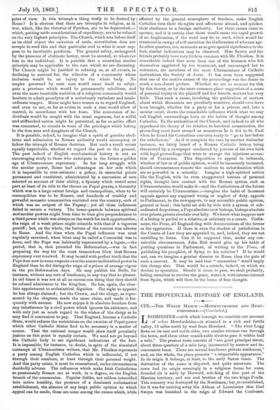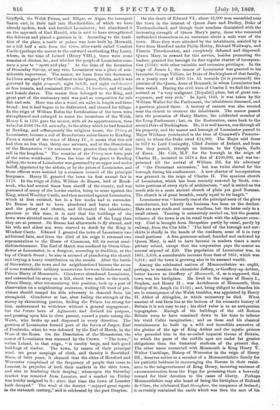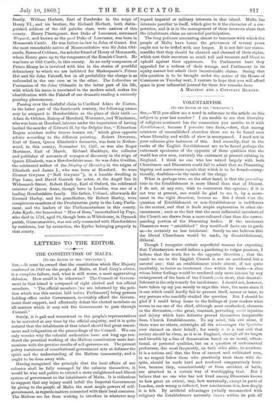Gryffyth, the Welsh Prince, and iElfgar, or Algar, the insurgent
Saxon earl, in their raid into Herefordshire, of which we have already spoken, took and fortified Leominster ; but abandoned it on the approach of Earl Harold, who is said to have strengthened the defences and placed a garrison in it. According to the tradi- tion of the place, a castle or palace was here built by Merwald, on a hill half a mile from the town, afterwards called Comfort Castle (perhaps the mount to the eastward overlooking Hay Lane), where, in the time of Leland (Henry VIII.), there were some remains of ditches, Scc., and whither the people of Leominster came once a year to "sport and play." At the time of the formation of Domesday Survey, at any rate, Leominster was a place of con- siderable importance. The manor, we learn from this document, had been assigned by the Confessor to his Queen, Editha, and it was governed by eight prsepositi, eight bedelli, and eight radchenistri or free tenants, and contained 238 villani, 74 bordarii, and 82 male and female slaves. The manor then belonged to the King, and great part of the customary rent was paid as composition for salt fish and eels. Here was also a wood, six miles in length and three broad ; but it had begun to be disforested, and cleared for tillage. In the reign of William Rufus the fortifications of the town were strengthened and enlarged to resist the incursions of the Welsh. Henry I. in 1125 gave the manor, with all its appurtenances, then valued at £666 19s. 8d. annually, to the abbey which he had founded at Reading, and cottsequently the religious house, the Priory at Leominster, became a cell of Benedictines subordinate to Reading. From a record of the time of Henry IV., it seems that this cell had then no less than thirty-one servants, and at the Dissolution of the Monasteries "its revenues were greater than those of any cell in the kingdom." The remains of the Priory now form part of the union workhouse. From the time of the grant to Reading Abbey, the town of Leominster was governed by an upper and under bailiff, appointed by the abbots, or by the priors of Leominster, and these officers were assisted by a common council of the principal burgesses. Henry II. granted the town its first annual fair in 1170. In the reign of John, William de Braose, lord of Breck- mock, who had several times been sheriff of the county, and was possessed of many of the border castles, being in arms against the King, seized Weobley Castle, and then marched against Leominster, which at first resisted, but in a few weeks had to surrender. De Braose is said to have plundered and burnt the town, and the priory and church, and ill-treated the inhabitants ; previous to this time, it is said that the buildings of the town were situated more on the western bank of the Lugg than they are at present. De Braose had afterwards to fly abroad, and his wife and eldest son were starved to death by the King in Windsor Castle. Edward I. granted the town of Leominster two additional fairs, and from the 23rd of his reign it returned two representatives to the Home of Commons, till its recent semi- disfranchisement. The Earl of March was confined by Owen Glen- dower at Leominster, in a dungeon, according to tradition, at the top of Church Street ; he also is accused of plundering the church and levying a heavy contribution on the monks. After the battle of Shrewsbury, the town and its neighbourhood became the scene of some remarkable military manoeuvres between Glendower and Prince Harry of Monmouth. Glendower abandoned Leominster, and entrenched his army on a hill, about two miles to the south. Prince Henry, after reconnoitring this position, took up a post of observation on a neighbouring eminence, waiting till want of pro- visions should compel his able adversary to descend from his stronghold. Glendower at last, after feeling the strength of the enemy by skirmishing parties, finding the Prince too strong for him, endeavoured to withdraw without a general engagement ; but the future hero of Agincourt had divined his purpose, and pressing upon him in close pursuit, caused a panic among the Welsh, who broke up and dispersed in every direction. The garrison of Leominster formed part of the forces of Jasper, Earl of Pembroke, when he was defeated by the Earl of March, in the Wars of the Roses. On the Dissolution of the Monasteries, the manor of Lsominster was resumed by the Crown. "The town," writes Leland, in that reign, "is meetly large, and hath good buildings of timber. The town, by reason of their principal wool, use great cirapings of cloth, and thereby it flourished. Since, of later years, it chanced that the cities of Hereford and Worcester complained of the frequency of people that came to Lemster, in prejudice of both their markets in the shire town, and also in hindering their draping ; whereupon the Saturday market was removed from Lemster, and a market on Friday was hereby assigned to it ; since that time the town of Lemster hath decayed." The wool of the district "enjoyed great repute in the sixteenth century," and is celebrated by the poet Drayton. On the death of Edward VI., about 13,000 men assembled near the town in the interest of Queen Jane and Dudley, Duke of Northumberland, and though their numbers diminished with the increasing strength of Queen Mary's party, those who remained entrenched themselves on an eminence about a mile west of the town. Here they were attacked by the inhabitants, assisted by a force from Hereford under Philip Hobby, Richard Wallwayn, and Francis Throckmorton, and completely defeated and dispersed. Queen Mary, in reward for this service, besides promoting the leaders, granted the borough its first regular charter of incorpora- tion (1554), with other valuable and extensive privileges. In the reign of James I., the manor of Leominster was granted to his favourite, George Villiers, 1st Duke of Buckingham of that family, on a yearly rent of £,305 us. 5d. towards (it is presumed) the jointure of the Queen, Anne of Denmark, in whom Leominster had been vested. During the civil wars of Charles I. we find the town noticed as "a very malignant [Royalist] place, but of great con- sequence, and very rich." In April, 1643, it was taken by Six- William Waller for the Parliament, the inhabitants disarmed, and a garrison placed there. A battery of cannon was also erected near the church to overawe the inhabitants. The manor passed into the possession of Harry Marten, the celebrated member of the Long Parliament ; but, on the Restoration, came back to the second Duke of Buckingham. He, it is well known, ran through all his property, and the manor and borough of Leominster passed to Major Wildman (celebrated in the time of CromwelPs Protecto- rate), to whom the Duke owed £14,000. -The Major sold them in 1672 to Lord Coningsby, Chief Justice of Ireland, and from him they passed, through an heiress, to the Capels, Earls of Essex. _Mr. Colt, M.P. for the borough in the reign of Charles II., incurred in 1678 a fine of 1100,000, and was im- prisoned till the arrival of William III. for his advocacy of "the Protestant succession," but was twice elected for the borough during his confinement. A new charter of incorporation was granted in the reign of Charles II. The spacious church of Leominster, which has been recently restored by Scott, con- tains portions of every style of architecture, "and is united on the
side to a more ancient church of plain yet good Norman. Thechurch is of great breadth, nearly equal to its length."
Leominster was " formerly one of the principal seats of the glove manufacture, but latterly the business has been on the decline.. Hatsare now made and coarse woollens, but the latter only to a small extent. Tanning is extensively carried on, but the present. reliance of the town is on its retail trade with the adjacent coun- try. Coal is brought from Shropshire partly by canal, partly by railway, from the Clce hills." The land of the borough and out- skirts is chiefly in the hands of the residents, some of it in very small portions. A free grammar-school, founded and endowed by Queen Mary, is said to have become in modern times a mere- private school, except that the corporation pays the master an annual -stipend of 120. The population of Leominster was, in 1861, 5,658, a considerable increase from that of 1851, which was 5,214 ; and the town is growing also in its assessed wealth.
Among the celebrated natives of Monmouthshire we ought, perhaps, to mention the chronicler Jeffery, or Geoffrey-ap-Arthur, better known as Geoffrey of Monmouth, if, as is supposed, that town was his birthplace. He lived in the reigns of Henry I., Stephen, and Henry II.; was Archdeacon of Monmouth, then. Bishop of St. Asaph (in 1152) ; and, being obliged to abandon his- see in consequence of the Welsh troubles, was appointed by Henry II. Abbot of Abingdon, in which monastery he died. What amount of real facts lies at the bottom of his romantic history of Britain it is not easy to say ; his chief value is as an antiquarian topographer. Enough of the buildings of the old Roman Britain seem to have remained down to his time to inflame- his vivid Celtic imagination ; and on these and his classical reminiscences he built up a wild and incredible narrative of the glories of the age of King Arthur and the mystic princes. who preceded him in the so-called imperial throne of Britain, to which the poets of the middle ages are under far greater- obligations than the historical students of the present day. The other name connected with Monmouth is King Henry V. Walter Cantilupe, Bishop of Worcester in the reign of Henry III., deserves notice as a member of a Monmouthshire family for his patriotic boldness in encouraging the Barons in their resist- ance to the misgovernment of King Henry, incurring sentence of excommunication from the Pope for promising them a heavenly reward for their devotion to the cause of liberty. Perhaps- Monmouthshire may also boast of being the birthplace of Richard de Clare, the celebrated Earl Stronybow, the conqueror of Ireland ; it certainly contained the castle which was then the seat of his
family. William Herbert, Earl of Pembroke in the reign of Henry VI., and his brother, Sir Richard Herbert, both distin- guished soldiers of the old paladin class, were natives of this county. Henry Plantagenet, first Duke of Lancaster, surnamed Wryneek, and known as the good Duke of Lancaster, was born in Monmouth Castle. He was father-in-law to John of Gaunt. But the most remarkable native of Monmouthshire was Sir John Old- castle, Baron of Cobham, the scholar friend of Henry of Monmouth, whom Henry gave up to the vengeance of the Romish Church. He was born at Old Castle, in this county. As an early companion of Prince Henry he is involved with him in the stories of youthful debauchery to which we are indebted for Shakespeare's Prince Hal and Sir John Falstaff, but in all probability the charge is as unfounded in the one case as in the other. The Lollardism or Puritanism of Sir John Oldcastle in the latter part of his life, with which his name is associated in the modern mind, makes his identification with the Falstaff of our dramatic reading a curiously puzzling phenomenon.
Passing over the doubtful claim to Cardinal Adam de Easton, in the latter part of the fourteenth century, the following names may be assigned to Herefordshire as the place of their birth :- Adam de Orleton, Bishop of Hereford, Worcester, and Winchester, who was born at Hereford, labours under the imputation of having incited the murder of Edward II. by the Delphic line, " Eduardum Regem occidere nolite tinaere bonum eat," which gives opposite advice according to the different pointing. Robert Devereux, Earl of Essex, Queen Elizabeth's favourite, was born in Nether- wood, in this county, November 10, 1567, as was also Roger Mortimer, Earl of March. Richard Hackluyt, the collector and publisher of accounts of voyages of discovery in the reign of Queen Elizabeth, was a Herefordshire man. So was John Gwillim, the celebrated author of the Display of Heraldry in the reigns of Elizabeth and James I., who was born at Hereford. So were Eleanor Gwynne (" Nell Gwynne "), in a humble dwelling in Pipe Lane, and David Garrick the actor, at the Angel Inn in Widemarsh Street. Robert Harley, Earl of Oxford, the celebrated minister of Queen Anne, though born in London, was one of a leading Herefordshire family. His father, Colonel, afterwards Sir Everard Harley, and his grandfather, Sir Robert Harley, were conspicuous members of the Presbyterian party in the Long Parlia- ment, and the leaders of the Parliamentarians in this county. John Kyrie, the benevolent "Man of Ross," immortalized by Pope, who died in 1724, aged 81, though born at Whitehouse, in Dymock parish, Gloucestershire, was not only connected with Herefordshire by residence, but by extraction, the Kyrles belonging properly to that county.
































 Previous page
Previous page